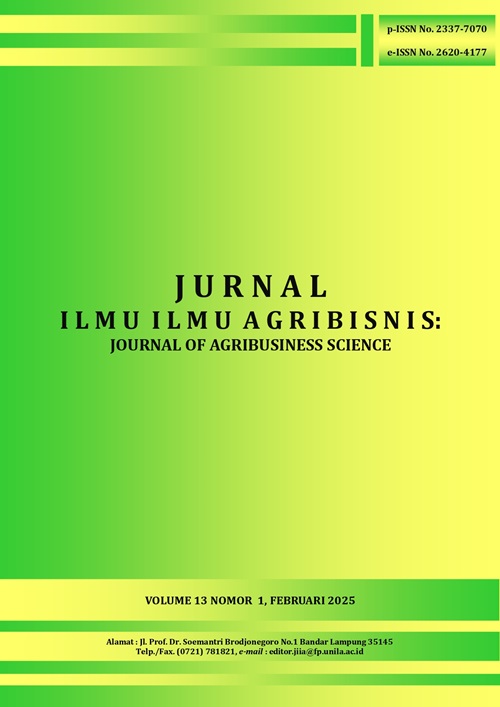ANALISIS SISTEM PEMASARAN CABAI MERAH DI PROVINSI LAMPUNG
DOI:
https://doi.org/10.23960/jiia.v13i1.9540 Abstract View: 193
Abstract View: 193
Abstract
This study aims to analyze the red chili marketing system in Lampung Province as seen from the market structure, market behavior and market performance. This research method is a survey method conducted in South Lampung Regency and Pesawaran Regency. The determination of respondents was carried out using accidental sampling method with a total of 67 red chili farmers. While the determination of trader respondents is done using snowball sampling technique where the implementation is in a chain that starts with conducting interviews to red chili farmers, then farmers will mention traders who become the next respondents. Research data were obtained from October to December 2023. The data analysis method used is the structure, conduct and performance (SCP) method. The analysis of market structure and market behavior is done descriptively qualitative while market performance is analyzed quantitatively by calculating marketing margin, farmer share, and Profit Margin Ratio. The results of market performance calculations show that the most efficient channel is channel II with consideration of the value of farmers share obtained is higher, the value of marketing margin is lower, the chain of channel II is shorter and the price received by end consumers is smaller than the other two channels.
Downloads
Downloads
Published
How to Cite
Issue
Section
License
Authors who publish with this journal agree to the following terms:
Authors retain copyright and grant the journal right of first publication with the work simultaneously licensed under a Creative Commons Attribution License that allows others to share the work with an acknowledgement of the work's authorship and initial publication in this journal.
Authors are able to enter into separate, additional contractual arrangements for the non-exclusive distribution of the journal's published version of the work (e.g., post it to an institutional repository or publish it in a book), with an acknowledgement of its initial publication in this journal.
Authors are permitted and encouraged to post their work online (e.g., in institutional repositories or on their website) prior to and during the submission process, as it can lead to productive exchanges, as well as earlier and greater citation of published work (See The Effect of Open Access).














